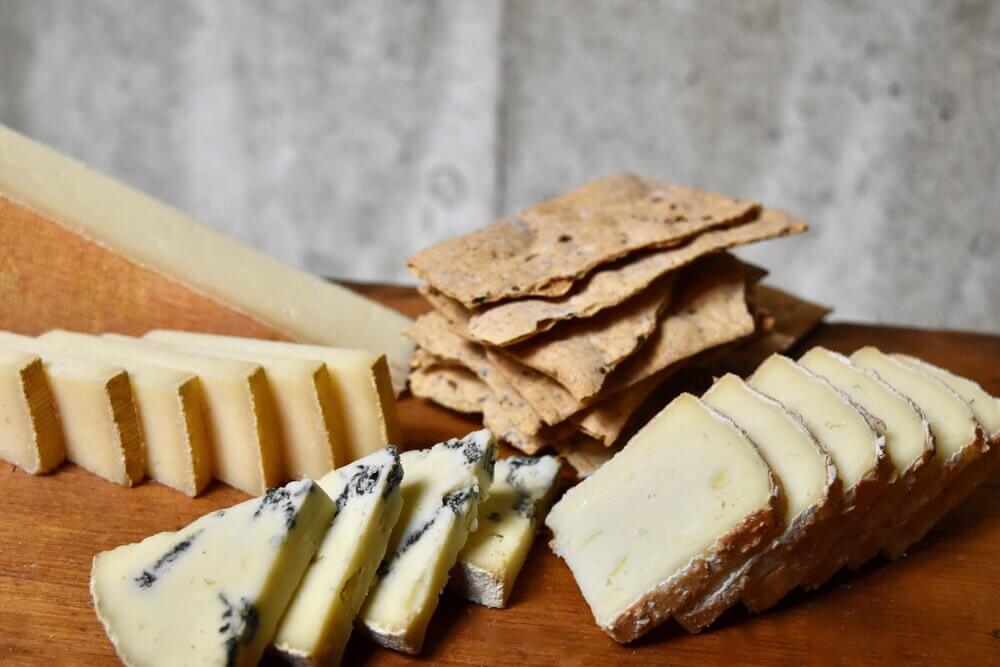Eating with the seasons isn’t only for fruits and vegetables.

We easily accept that summer is the time for sweet corn and tomatoes, and fall is the season for hearty squashes and orchard fruits—at least where I live in the northern hemisphere. But rarely do we give the same thought to cheese.
Why not? Cheese is an agricultural product, too, made primarily from milk, and certain cheeses are only made and/or released during certain seasons.
“Most cheese companies are not utilizing seasonality, because consumers drive year-round demand for consistency,” says Brian Civitello, founder and cheesemaker at Mystic Cheese Co. in Groton, Connecticut. And yet, every cheesemaker knows that the ebb and flow of the seasons has a significant impact on their cheese. Milk changes in composition and character throughout the year based on what the herds are eating, the temperatures outside and animals’ reproduction cycle—when cows (or sheep or goats) are going in and out of lactation.
“The fat-to-protein ratio in the milk is the major factor that shifts according to the seasons,” according to Civitello. Fat and protein from milk, separated from the liquid by way of fermentation, are the fundamental building blocks of cheese. Because markets usually demand relative consistency—customers want to know exactly what they’re getting when they cut into a certain wedge or wheel—most cheesemakers “change their timing, temperatures and recipes ever so slightly if that ratio gets too far out of whack,” explains Civitello. Even so, “cheese is definitely not the same year-round.” Nor should it have to be.
A delicious example that showcases the beauty of seasonality in cheese is Grayson, made by Meadow Creek Dairy in Virginia’s Blue Ridge Mountains only when their cows are on pasture, from April to October. It’s then aged anywhere between 60 and 90 days, meaning it comes in and out of availability throughout the year. It’s beefy, oniony and intense, and yet the wheels transform in flavor and intensity from one month to the next, making them a cheesemonger favorite and a cheese lover’s thrill.
When thinking about cheese and the seasons, it helps to zoom way out. “Cheese has always been an economic response to a landscape, a way for humans to create nourishment and wealth wherever they are in the world,” says Zoe Brickley, director of communications and e-commerce at Jasper Hill Farm in Greensboro, Vermont.
An excellent example of that resourcefulness is Comté, a cheese made in France’s Jura Mountains, right on the border of Switzerland. Comté was born out of necessity, not luxury, about a thousand years ago. Its process marked the unfolding of each year. The Jura winters are brutal, snowy and long. Making Comté cheese was a way to preserve milk into hearty wheels that could feed villages for many months. Farmers led their herds up the mountains in the summer to take advantage of the short season of green grass and plentiful blossoms, then returned to lower-altitude pastures when the first frosts came. As the herds ambled downward in autumn, the local cows were celebrated with flower garlands and town festivities—a cow parade called transhumance that continues to this day.
Spring and summer offer both advantages and challenges to cheesemakers. The pros: First grasses and wildflowers mean animals’ milk is flavorful and nuanced, which can show up as lovely notes in cheese. The cons: “It’s hard to work with,” says Brickley, since summer milk has less fat and a higher water content. Traditionally, recipes for cheeses made with partially skimmed milk (such as Alpine wheels and Parmigiano-Reggiano) are well suited to summer milk, which will be made in the warm seasons and set aside to age for months or even years to come.
I love the cheeses made from winter milk, when the herds eat more hay and grains, and the fat content of their milk skyrockets. This milk is ideal for high-moisture, gooey cheeses such as Vacherin Mont d’Or one of the world’s most sought-after wheels. The runny, funky cheese is made near where Comté is produced, right across the border in Switzerland, from fall and winter milk. The cows produce less milk as the days get shorter and cooler, but the milk they do give is richer in fat, which is preferable for making small, soft, oozy wheels such as Vacherin.

Winnimere, Jasper Hill’s take on a Jura Mountain cheese. Photo courtesy of Jasper Hill Farm.
In Vermont, Jasper Hill makes its own take on a seasonal cheese known as Vacherin, which is made in France and Switzerland. It’s called Winnimere, crafted exclusively during winter months when the farm’s Ayrshire cows produce super-rich, hay-fed raw milk. In a practical way, marketing this “exciting, rare cheese helps sales and momentum going” in January, when cheese sales dip after the holiday boom, according to Brickley.
When it comes to goats, many smaller producers rest their herds during the colder months of winter. With sheep, ewes lamb once a year, so sheep’s milk is mostly available in spring and summer. If you’re buying “fresh” goat and sheep cheeses outside of those seasons, it’s most likely made with powdered milk or frozen curds—a bit “of an industry secret nobody wants to talk about,” says Civitello.
A great way to dig into cheese and seasonality is to explore small-batch, handmade cheeses (even better if you can find a trusted cheesemonger to guide you). Maybe they’ll share a taste of high-summer Grayson, or Rush Creek Reserve, available only in the late fall from Upland Cheese in Wisconsin, a soft-ripened cheese wrapped in spruce bark that tastes like savory pudding and pure luxury. For the ultimate cozy, celebratory experience, serve some Rush Creek Reserve with warmed autumn apples wrapped in bacon or pancetta. It’s a delicious enough tradition to look forward to each year.
Hannah Howard is the author of the memoirs Feast and Plenty.
Nice story, but looking at these sellers’ websites, their prices/shipping are prohibitive. I’d find it easier and less expensive to shop locally for the various cheeses.
Thank you for this article. I think its underlying message is applicable to all aspects of consumable and non-consumable agriculture. Vegetables whose flavor transforms after the frost, honey that tastes of its local landscape, and so on. We should be thinking about seasonality and terroir in combination.
Useful information. Of course, the taste of the cheese really depends on the season. But this only applies to private cheese factories. Manufacturers of industrial scales do not collide with these.